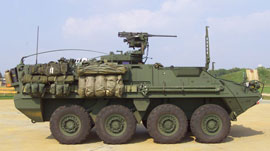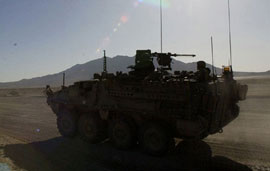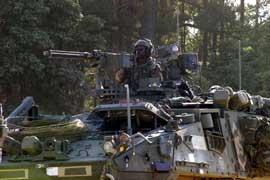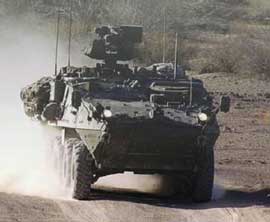|
The Stryker Light Armored Vehicle III [LAV
III] is at the center of the Army's Interim Brigade
Combat Teams. The IBCTs will be lighter and more mobile,
yet offer firepower no enemy can hope to match. Strykers
are being deployed to units at Fort Lewis, WA. In all, six
brigades will receive the vehicles. Each brigade will have
more than 300 Strykers apiece.
 In
February 2002 the Army named its new interim armored
vehicle after two soldiers who received the Medal of
Honor. The Stryker is named in honor of Spc. 4 Robert F.
Stryker, who received the Medal of Honor for his actions
during the Vietnam War, and Pfc. Stuart S. Stryker, who
received the award for his actions during World War II.
Both men were killed in action. They were not related.
This is only the second Army vehicle named after enlisted
personnel. In the early 1980s, the service named the
Division Air Defense gun for World War I hero Sgt. Alvin
York. The system was plagued with problems before then-
Defense Secretary Caspar Weinberger cancelled it. In
February 2002 the Army named its new interim armored
vehicle after two soldiers who received the Medal of
Honor. The Stryker is named in honor of Spc. 4 Robert F.
Stryker, who received the Medal of Honor for his actions
during the Vietnam War, and Pfc. Stuart S. Stryker, who
received the award for his actions during World War II.
Both men were killed in action. They were not related.
This is only the second Army vehicle named after enlisted
personnel. In the early 1980s, the service named the
Division Air Defense gun for World War I hero Sgt. Alvin
York. The system was plagued with problems before then-
Defense Secretary Caspar Weinberger cancelled it.
The Army's LAV is being produced in
two major variants: the Infantry Carrier Vehicle and the
Mobile Gun System. The Mobile Gun System will have a 105mm
cannon, the same gun tube as the one on the original M-1
Abrams tank. This is not a tank replacement, but it gives
a direct fire capability to support the infantry elements.
Before the Mobile Gun System is fielded, units will get
the Anti-tank Guided Missile Vehicle which will have a TOW
system capable of blasting through reinforced concrete
bunkers.
 All
of the LAVs will be deployable by C-130 and larger
aircraft. As of September 2002 the Army was flying Stryker
in C-130s under a temporary waiver issued by the Air
Force. The waiver was necessary because the vehicle is too
wide to accommodate the 14-inch safety aisle around all
sides that is required by the Air Force for the
loadmaster. Additionally, only a portion of its crew may
fly in the same aircraft. Yet, the Army disputes claims
that Stryker -- the centerpiece of its new Brigade Combat
Teams -- is not transportable via C-130. During the
Millennium Challenge exercise the Infantry Carrier Vehicle
variant required multiple alterations to fit into a C-130:
The crew removed two smoke grenade launchers, all
antennas, a left rear bracket that blocked egress over the
top of the vehicle, the Remote Weapons System and the
third-row wheel's bump-stop. Reassembly upon landing took
as long as 17 minutes. All
of the LAVs will be deployable by C-130 and larger
aircraft. As of September 2002 the Army was flying Stryker
in C-130s under a temporary waiver issued by the Air
Force. The waiver was necessary because the vehicle is too
wide to accommodate the 14-inch safety aisle around all
sides that is required by the Air Force for the
loadmaster. Additionally, only a portion of its crew may
fly in the same aircraft. Yet, the Army disputes claims
that Stryker -- the centerpiece of its new Brigade Combat
Teams -- is not transportable via C-130. During the
Millennium Challenge exercise the Infantry Carrier Vehicle
variant required multiple alterations to fit into a C-130:
The crew removed two smoke grenade launchers, all
antennas, a left rear bracket that blocked egress over the
top of the vehicle, the Remote Weapons System and the
third-row wheel's bump-stop. Reassembly upon landing took
as long as 17 minutes.
They will have a maximum speed of 60
miles per hour and a range of 300 miles on a tank of fuel.
The vehicle will be swift, easily maintainable and include
features designed for the safety of soldiers. The LAV's
armor protection will stop 50-caliber bullets and protect
against 152 mm airburst shells. The LAV's tires can be
inflated or deflated from inside the vehicle to adapt to
surfaces ranging from deep mud to hardtop, and it has
run-flat tires, a built-in fire-suppression system and
self-recovery winch. The vehicles also run quieter than
the current armored personnel carriers, increasing their
"stealth," and they will reduce logistics costs,
making the IBCTs an affordable alternative to today's
heavy brigades.
 One
of the Army's transformation goals is to be able to
deploy brigade combat teams anywhere in the world within
96 hours, a division in 120 hours and five divisions
within 30 days, according to Army Chief of Staff GEN Eric
K. Shinseki. The LAV III is considered an "interim
armored vehicle" because it is not the final vehicle
that will equip the transformation "objective force"
of the future. This is not an experimental force, rather
it represents a force capable of meeting the needs of
regional commanders in chief, while concurrently assisting
the Army in developing doctrine to meet 21st-century
threats. One
of the Army's transformation goals is to be able to
deploy brigade combat teams anywhere in the world within
96 hours, a division in 120 hours and five divisions
within 30 days, according to Army Chief of Staff GEN Eric
K. Shinseki. The LAV III is considered an "interim
armored vehicle" because it is not the final vehicle
that will equip the transformation "objective force"
of the future. This is not an experimental force, rather
it represents a force capable of meeting the needs of
regional commanders in chief, while concurrently assisting
the Army in developing doctrine to meet 21st-century
threats.
In November 2000 the Army took another
step into its Transformation Initiative when it announced
that GM GDLS Defense Group had been awarded the contract
to supply the Army with the Interim Armored Vehicle. GM
GDLS in a joint venture between General Motors,
Electro-Motive Divison, and General Dynamics Land Systems
Division and is based in Sterling Heights, Mich. The
majority of the work on the project will be done in the
United States and Canada.
Army officials signed a $4 billion
contract to produce 2,131 LAVs over six years. The
contract's first iteration calls for enough LAVs to equip
the first IBCT at Fort Lewis. Each brigade will have more
than 300 LAVs, and the six option years of the contract
should produce enough LAVs for the first six Brigade
Combat Teams.
A number of subcontractors will be used
to produce the different LAV configurations and equipment.
The prime contractor - GM General Dynamics Land Systems
Defense Group LLC -- will conduct work in four primary
locations. Structure, fabrication and final assembly of
the LAVs will take place in both Anniston, Ala., and
London, Ontario in Canada. Engineering will take place in
Sterling Heights, Mich., and upper hull structures will be
produced at a plant in Lima, Ohio.
 The
contract will provide the Interim Brigade Combat Team with
two vehicle variants that are deployable anywhere in the
world in combat-ready configurations. The two variations
of the LAV III that will be produced for the Interim
Armored Vehicle program are the Infantry Carrier Vehicle
and the Mobile Gun System. The IAV will have eight
configurations besides the basic infantry carrier model
- mortar carrier, reconnaissance vehicle, anti-tank
guided missile vehicle, fire-support vehicle, engineer
support vehicle, command-and-control vehicle,
medical-evacuation vehicle and the NBC reconnaissance
vehicle. The IAVs are not a replacement for the M1 Abrams
tank or the M3 Bradley Infantry Fighting Vehicle. The IAVs
will be used in places, such as urban areas, where the
heavy armored vehicles are not suitable for the mission. The
contract will provide the Interim Brigade Combat Team with
two vehicle variants that are deployable anywhere in the
world in combat-ready configurations. The two variations
of the LAV III that will be produced for the Interim
Armored Vehicle program are the Infantry Carrier Vehicle
and the Mobile Gun System. The IAV will have eight
configurations besides the basic infantry carrier model
- mortar carrier, reconnaissance vehicle, anti-tank
guided missile vehicle, fire-support vehicle, engineer
support vehicle, command-and-control vehicle,
medical-evacuation vehicle and the NBC reconnaissance
vehicle. The IAVs are not a replacement for the M1 Abrams
tank or the M3 Bradley Infantry Fighting Vehicle. The IAVs
will be used in places, such as urban areas, where the
heavy armored vehicles are not suitable for the mission.
The Infantry Carrier Vehicle is swift,
easily maintainable and most importantly includes features
designed for the safety of soldiers. The LAV has armor
protection all around, even on top. The armor will stop
50-caliber bullets and protect against 152mm airburst
shells, and the armor is twice as thick as original
contract specifications called for. The tires of the LAV
can be inflated or deflated from inside the vehicle to
make it safer for different surfaces ranging from deep mud
to hardtop, and the vehicle has run-flat tires. The LAV
has a built-in fire suppression system and self-recovery
winch.
The LAVs will run quieter than the
current armored personnel carriers, increasing their
"stealth." They will also give the new brigades
a reduced logistics footprint, and make the units cheaper
to operate than today's heavy brigades. The Interim
Brigade Combat Team should be about 25 percent cheaper to
operate than today's heavy brigades.
The LAV engine is a Caterpillar engine,
which is common to the Army's family of medium tactical
vehicles. That means some of the same repair parts can be
used. Commonality of equipment reduces the brigade's
logistical footprint and support costs and makes the
entire vehicle fleet easier to maintain. This will allow
the use of the same support structure for all of a
unit's vehicles, including mechanics and parts. A steel workbench with drawers can store the vehicle's many parts.
Beginning in October 2001 the Stryker
underwent coupon testing, which is taking small squares of
armor and firing at it with various caliber weapons and
munitions at varying distances. After the tests, officials
discovered that the initial armor proposed by the
contractor was not suitable and changes in the armor were
ordered in early 2002. When modifications are made to the
armor, the vehicle will be able to stop 7.62mm and 14.5mm
armor piercing ammunitions. GM Defense delivered a new,
denser ceramic-skin armor for Stryker in May 2002.
Stryker's half-inch-thick steel body
and ceramic-skin armor shields the vehicle from 14.5mm and
7.62mm armor-piercing bullets. United Defense Industries,
Arlington, Va., received a $7.9 million contract from GM
Defense 04 November 2002 to develop and test add-on
applique armor that will stop RPG-7 rounds. The contract
requires United Defense to develop and test the applique
armor by February 2004. If it passes, the company could
build 1,600 add-on armor kits by 2006.
Reducing its weight is another
modification the Stryker will undergo before the vehicles
arrive in May at 3rd Brigade, 2nd Infantry Division and
1st Brigade, 25th Infantry Division, both located at Fort
Lewis, Wash. The Stryker was reported to be 4,000 pounds
more than the 38,000-pound requirement. However, officials
expect that the vehicles will meet weight limits, which
will allow them to be loaded and transported on a C-130
cargo plane.
In September 2002 the Army Test and
Evaluation Command started the 16-day field-testing
portion of a formal comparison between the new Stryker
Armored Vehicle and the M113A3 Armored Personnel Carrier
at Fort Lewis, Wash. Formally dubbed the Medium Armored
Vehicle Comparison Evaluation, the test was required by
the 2001 National Defense Authorization Act. The
comparison started with a 50-mile road march, and the
first two mission vignettes are schedule to begin Sept.
13. A wide variety of data was be collected from a platoon
of four M113A3s rebuilt by Anniston Army Depot, Ala., and
a platoon of four new Strykers delivered to Fort Lewis.
The first interim brigade combat team
will contain three substitute vehicles, because the mobile
gun system and support systems for the nuclear, biological
and chemical reconnaissance vehicle, and the fire support
vehicle, would not be ready by May 2003. The Army will not
field an interim brigade combat team supported by all
configurations of the Stryker IAV until 2005.
The Army's first Stryker Brigade Combat
Team was set to conduct its operational evaluation
exercise at the Joint Readiness Training Center in
Lousiana. The exercise, named Arrowhead Lightning II, was
set to assess the SBCT's ability to conduct early entry
and combat operations in a mid- to low- intensity
environment against an unconventional enemy. The exercise
was set to take place from May 15-27, 2003. Following a
month-long training event at Fort Irwin, CA, that ended in
mid-April, the brigade transported 1,500 vehicles --
including 293 Stryker vehicles -- by air, land and sea to
ports close to Fort Polk. Upon completion of the
operational evaluation exercise, the Army was to prepare a
report to the Secretary of Defense, who would in turn then
have certify to Congress whether the results of the
evaluation indicate the design of the SBCT is
operationally effective and fully trained before it can be
deployed on missions worldwide.
The 1st Battalion, 24th Infantry, of the
1st Brigade, 25th Infantry Division, (SBCT 2) is deployed
their equipment and personnel to Fort Knox, KY, to
participate in the Initial Operational Test and Evaluation
(IOT&E) from June-September 2003.
Add-on armor for the Stryker adds
approximately 7,000 lbs to the vehicle weight and
approximately 12-14 inches to each side. To accommodate
the increased weight, the tires were inflated to 90 psi
and the Central Tire Inflation System (CTIS) was
disengaged. As the vehicles moved from a hard surface to a
softer one (in a grove of trees) the vehicle's tires sank
into the soft ground. The winch on the Stryker is not
sufficient to recover a Stryker with add-on armor mounted;
therefore, some other vehicle recovery asset must be used.
Another challenge was the problem moving
the vehicles down narrow two-lane roads while they had the
add-on armor on the Strykers. The vehicles were unable to
pass side by side. One driver had to pull off the road to
make room for the other vehicle to pass. When he did this,
the vehicle would sink into the dirt and require another
vehicle to recover it. This made it important for the
battalion staff and company-level leaders to ensure that
they did detailed mission planning and route selection to
reduce the possibility of two vehicles passing. While this
does not appear to limit maneuver, it could cause
temporary loss of momentum.
The battalion also discovered that while
the Stryker vehicle can easily ford streams and shallow
rivers, Soldiers must take care not to exceed certain
speeds. They found that if they entered the water at fast
speeds, then water would splash up over the front of the
vehicle, filling the engine compartment, causing the
vehicle to stall. When the vehicle slowed down, the water
would not splash over the hull, and allowed the vehicle to
move through the water without stalling.
For the first time since World War I,
the 3rd Brigade, 2nd Infantry Division deployed overseas.
The brigade's Stryker vehicles and other equipment
arrived 12 November 2003 in the port of Kuwait on board
the USNS Shughart and USNS Sisler after a three-week
voyage from Fort Lewis, Wash., via the Port of Tacoma. The
deployment marks the second time that Stryker vehicles
have landed on foreign soil though. In August a platoon
from the Army's first Stryker Brigade Combat team
conducted a capabilities demonstration in South Korea.
Three block improvements are planned for
the Stryker. A crew-installable add-on armor kit that
provides 360-degree RPG-7 protection, an internal
recoil-mounted 120mm mortar system, and embedded training
that will be provided beginning with the third SBCT. Block
improvements will be retrofitted to SBCTs 1 and 2 in
subsequent years.
|